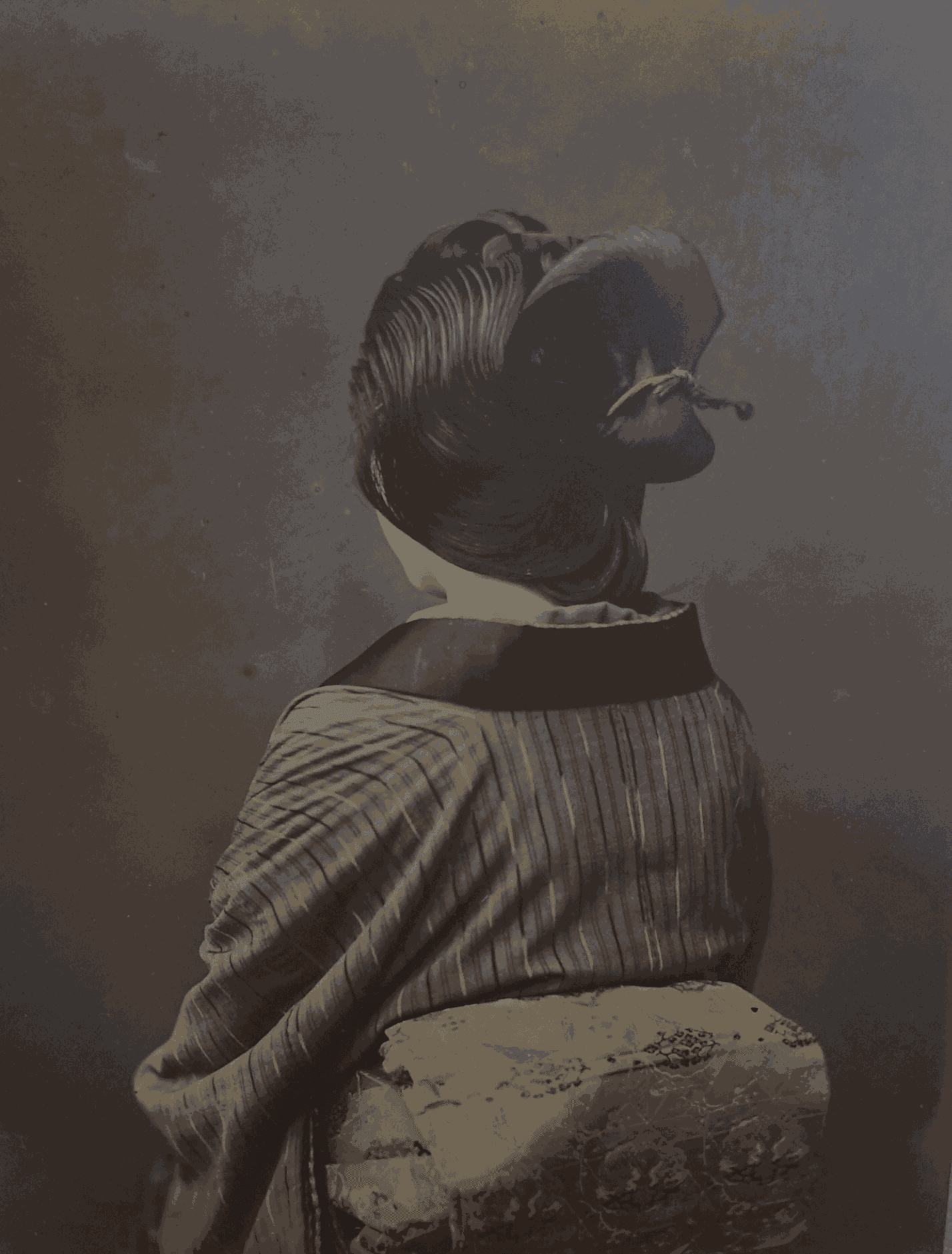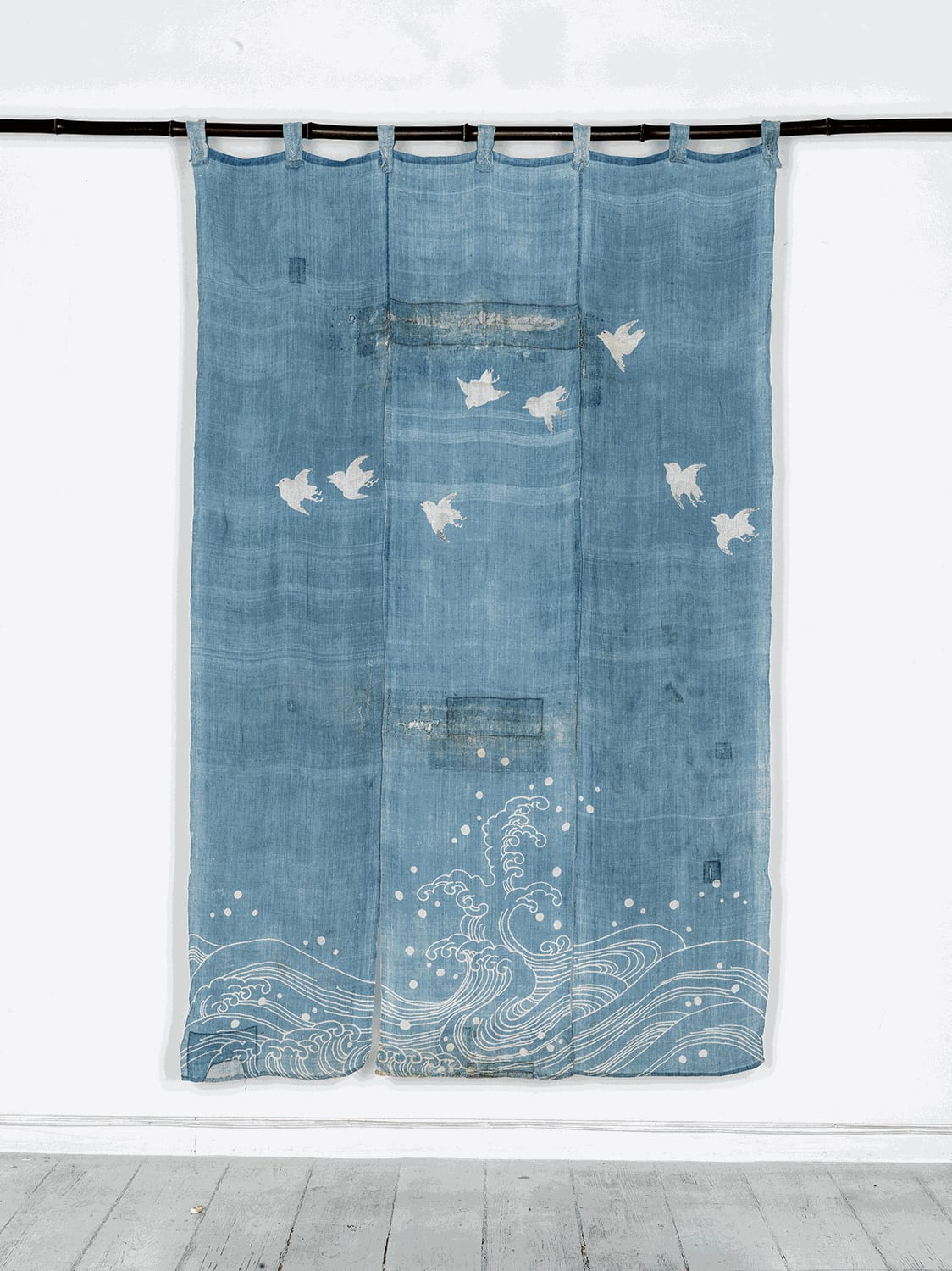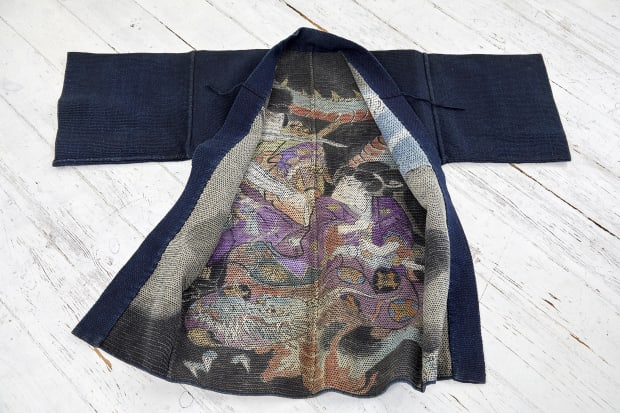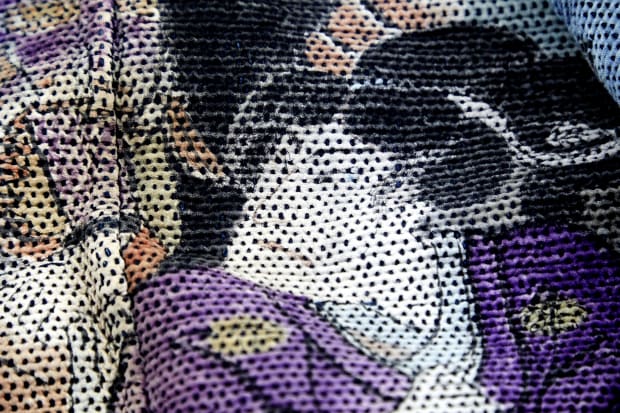Michael Hoppen is delighted to present OKASHI, our long-awaited exhibition of all things Japanese – neither a delicate vision of 'The Floating World,' nor the kawaii kitsch of Hello Kitty’s homeland. Displaying a kaleidoscope of works from across different periods and media, this selection represents the gallery’s longstanding interest in Japan, to illustrate an eclectic understanding of its rich visual culture. Spanning photography, textiles, avant-garde theatre posters, woodblock prints and unusual objects such as netsuke and harigata, this selection seeks to contextualise the gallery’s longstanding interest in Japanese culture
-
-

EIKOH HOSOE
ORDEAL BY ROSES # 32, 1961 -
Okashi
By Michael HoppenMy love affair with Japan started in the 1980’s when I bought my very first ‘vintage photograph’ in Portobello Road in London. It was a 19th century albumen print showing two sumo wrestlers, bodies entwined and posed looking at the camera. It was so completely artificial and theatrical - clearly designed for western audiences - but I now realize that this was the moment that I felt the hook sink in, and I was ready to discover what else was out there. I had been very influenced by early 1970’s ZOOM and PHOTO magazines, which periodically showed current Japanese photography trends unlike anything I had seen. I was aware of something going on that was taking a completely different path to that of European and American photography.
I went to Tokyo for the first time in 2003 and I have travelled to Japan several times each year since then, discovering more and more on every visit. Whilst always focusing on photography, it would have been impossible (almost criminal!) to resist the myriad other fine arts, design, architecture, graphics, manga, comics, shunga, ceramics, textiles, technology and food that are presented to one's senses each day in Japan. From the simple to the complex, the sophisticated to the simply bizarre, Japan presents endless permutations and connections. I have enjoyed all of these and more.
-
 Utagawa Kunisada (Toyokuni), Praying for Hits in the Waterfall of Answered Prayers. Triptych, 1870
Utagawa Kunisada (Toyokuni), Praying for Hits in the Waterfall of Answered Prayers. Triptych, 1870 -
"Tattoos are another fascination of mine - particularly Japanese tattoos - as they are often of such wonderful quality, and their rich use of colour is legendary. I was lucky enough to spot a beautiful woodblock engraving by Utagawa Kunisada from the early mid 19th century at an auction in Tokyo a few years ago, and I was immediately drawn to it. It possessed not only that deep indigo blue synonymous with Japan, but also a great narrative and excellent tattoos! I was able to buy the piece against stiff local competition and it became one of the key pieces for OKASHI. It shows a group of superbly engraved men, bathing together beneath a waterfall. They are kabuki actors - Ichimura Uzaemon XIII, Sawamura Tanosuke III, and Sawamura Tosshō II, shown standing underneath the "Waterfall of Answered Prayers.” While this image depicts the actors in their dramatic guises, the appearance of the actors also hints at a play on popular culture. Although kabuki actors would not have had tattoos, the figures in the water sport wonderfully bold inked designs. Perhaps they are firemen or possibly yakuza? The colour, composition and design are very special, and encapsulate the essense of what I have been looking at.
-
"My fascination with Japan was first provoked by seeing Japanese photobooks and magazines as a young photographer during the 1970's. So when I first visited Japan some 20 years ago, I was completely blown away by its energy and diversity. Whilst photography was and still remains my key passion, I was enthralled and seduced by almost everything I laid eyes on."
- Michael Hoppen
-

UNKNOWN PHOTOGRAPHER
Japanese woman showing back of hair and obi (sash), C. 1885 -
 Unknown Photographer, Sumo Wrestler’s, Japan, 1880’s
Unknown Photographer, Sumo Wrestler’s, Japan, 1880’s -

Nobuyoshi Araki
Tokyo from a private collection, 1991 -
"I wanted to pick out certain unique items that I have acquired in the course of my inquisitiveness and acquisitiveness. I attach no particular timeline nor exceptional monetary value to these items, although most are rare and not at all easy to find. All that I have found I have enjoyed acquiring, and I now felt the time was right to show these pictures and various objects together, to see how they resonate with one another in small but often significant ways."
- Michael Hoppen
-
PHOTOGRAPHS
-
Barakei, most commonly translated as Ordeal by Roses, is a series of photographs, which would prove a breakthrough in Hosoe’s career, and as one of the last projects Mishima undertook before his sensationalist suicide, it illustrates the author’s final vision of how he wanted to be understood and remembered. The moment I first encountered the extraordinary book that presented this series, I was smitten and since then have wanted to show these works. There is one image in particular that has always drawn me to it. It depicts Mishima lying on his back and his body seems to be bound in a thick metal tube. His body is foreshortened by the camera viewpoint and I imagine Hosoe lying on his stomach, camera at ground level, focusing down along Mishima’s body creating this memorable surreal landscape.
-
Eikoh Hosoe is one of Japan’s most celebrated post-war photographers, who continue to be cited by contemporary artists including Moriyama Daido and Araki Nobuyoshi as a critical influence. Hosoe was a leading figure amongst the generation of photographers who rose to fame in the aftermath of the war, breaking with traditions of documentary and reportage photography to experiment with more subjective perspectives and a sophisticated, highly personal use of symbolism. As a member of the VIVO collective (1957-1961), Hosoe worked alongside artists including Tomatsu Shomei, Kawada Kikuji and Ikkō Narahara, to pioneer a new mode of photographic expression that confronted the radical transformation of Japanese society.
-
Hosoe had caught Mishima’s eye with his charged photographs of experimental butoh dancer Tatsumi Hijikata (see Kinjiki, 1960, and Kamaitachi, 1969) and the young photographer was originally commissioned to shoot Mishima’s portrait for a new book of critical essays. Hosoe was immediately struck by the strange and ostentatious style of Mishima’s home, shortly followed by his surprise at the famous writer’s appearance: ‘On the veranda, Mishima, half-naked and wearing dark glasses, was sunbathing in a white garden chair.’ Mishima invited Hosoe to photograph him however he pleased, and Hosoe returned many times over the coming months to work with Mishima on these complex and ornately stylised portrait. Hosoe’s impression of Mishima used the baroque aesthetics of the writer’s home and incorporated imagery from Botticelli and Dali to create a densely imaginative, subjective reflection of the author.
In 1970, Mishima shocked the world with his dramatic ritual suicide. After a failed coup, in which Mishima led a private militia to Tokyo’s military headquarters, the writer publically disemboweled himself in ultimate sacrifice to his nationalist ideals. In the months before, Mishima had worked closely with Hosoe and designer Tadanoori Yokoo to produce a completely redesigned second edition of Barakei. Mishima’s inclusion of a new final section to the book entitled ‘Death’ suggested to Hosoe that Mishima intended this publication as a kind of requiem. In his closing comments to the book, Hosoe celebrates Mishima’s spectacular idealism even as he admits its fatal role in the life of his long-term collaborator: ‘Here is the perfect body of Mishima, who never admitted the decay of the flesh.’
-
Eikoh Hosoe's Barakei - in conversation with author and curator, Mark Holborn
-
POSTERS
-
I knew a little about Tadanori Yokoo – but was not really aware of his extraordinary output until I was introduced to a collector in Japan who showed me many of the works he had designed and made and, there was this light-bulb moment. I knew his references and the clear influence he had had on the art in the West during the late 1960’s and the 1970’s. This particular piece, 'Stranger from the Wilderness', has become a firm favourite already. I am fascinated by Tadanoori Yakoos’ complete oeuvre and it has had a huge impact on me since connecting his work to Eikoh Hosoe and also with the Beatles, who I was a major fan of when I was much younger than today.
-

TADANORI YOKOO
Stranger from the Wilderness, 1969 -
This selection of posters was created in relation to experimental theatre projects which thrived in Tokyo during the 1960s and ‘70s. The angura scene (derived from English word ‘underground’), which encompassed avant-garde dance, film and performance, attracted many of the most influential artists of the day who designed posters to promote events and happenings. At a time when the boundaries between the disciplines of art, graphic design and illustration were relatively fluid, creatives including Yokoo Tadanori and Aquirax Uno rose to prominence with their iconic posters which explored the shared territory between these arts.
This selection includes several posters created for two of the most famous angura companies, Tenjō Sajiki (an ironic reference to the cheapest seats in the upper galleries of theatres) and Jōkyō Gekijō (‘Situational Theatre’). Legendary director Terayama Shūji was at the heart of their dramatic activities, which often involved appropriating new spaces for provocative performances in parks and other public areas. Terayama’s anarchic, transgressive vision is clear in such posters, which resound with audacious wit and graphic humour. The use of block colour screen-printing was perfect for ephemeral posters, designed to make an immediate impression on Tokyo’s crowded streets. These posters are now rare, with few original examples of artists’ designs surviving today, but they testify to a moment of radical enthusiasm and creative liberty which continues to resonate today.
-
TEXTILES
-
At a textile fair in London, a Japanese dealer bought a beautiful Ramie Noren curtain to show me and that I was delighted to buy. It is a gentle pale blue with exquisite white restrain designs of clouds and larks speeding above and below them whilst a fresh torrent of water rushes across the lower section in brilliant swirls of white restrain dyed elegance. The curtains are old, probably early 19th century, and were obviously very well used and had been repaired and washed over many years. But the essence and integrity and structure of their original purpose and design were in tact. The evidence of use and the small repairs softly stitched to the original are perfect examples of Wabi-sabi which is the Japanese aesthetic tradition of appreciating the process of ageing and imperfection.
And to add another layer, the blue, I discovered, was in fact not the result of ageing, but the practice of fine dying with an exhausted solution of indigo! To control this so evenly was a very difficult tradition to master and I have since added some beautiful summer kimonos made from a fine hemp weave, which whilst stiff is very cool to wear in the summer and is similarly dyed in the same tradition. It is a special blue that it hard to compare to anything else.
-
 Antique hand woven indigo ramie noren door curtain
Antique hand woven indigo ramie noren door curtain -
I bought a fine 19thcentury Japanese fireman’s jacket many years ago. I was initially drawn to it as it had a wonderful indigo colour to the weave. This jacket started a love affair with Japanese indigo garments and cloth which endures to this day. Abut the biggest surprise was when I opened the jacket and found inside an intricate hand painted scene of a Samurai and his bride. Firemen during the Edo period wore reversible uniforms, which after a successful firefight, were turned inside out to present elaborate and colorful designs as they victoriously paraded through the streets. The firemen would often also have these designs tattooed on their torso. The jacket is heavy and thick and stuffed with a type of cotton kapok that is very absorbent. Fireman would often soak their jackets in water before entering a blazing wooden building enabling them greater protection from the extreme heat. Jackets such as this one are very rare finds and in this condition, even more so.
-
-
SHUNGA
-
I first came across Shunga whilst working on an Araki exhibition in Japan some 20 years ago. He showed me some beautiful shunga engravings he admired – and I was immediately captivated by their unique qualities. The engravings were so fine and I loved the way the hands and the couples expressions were illustrated. I also found it interesting and beautiful that couples were more often partially clothed during sex – their fine kimonos, their perfectly coiffed hair and their bedrooms adorned with wonderful designs, giving a whole new vista to the art of erotica.
In the West, we treat erotic moments so differently and the Japanese version seemed so refined and at the same time so innocent in comparison. Shunga, literally “spring pictures”, is an erotic artistic tradition that emerged from early modern Japan, featuring graphic images of sexual activity. So much in Japan is shrouded in strange and sometimes unusual juxtapositions and euphemisms, and this is not exclusive to shunga.
-
Produced during the Edo period (1600-1868), shunga offered sexuality a shameless visual platform, where sexual pleasure, female sexuality, and homosexuality were not only acknowledged but encouraged. Typically executed as a kind of ukiyo-e, often in woodblock print format and whilst quite rare, there are also extant erotic painted handscrolls which predate ukiyo-e. I was lucky enough to see not only the British Museum show but also the Japanese version of the exhibition in Japan the year afterwards. The audiences for the two shows behaved in such different ways and that in itself was illuminating.
-
“At its best, shunga celebrates the pleasures of lovemaking, in beautiful pictures that present mutual attraction and sexual desire as natural and unaffected.”
— Tim Clark, curator of “Shunga: Sex and Pleasure in Japanese art”
-
OKASHI
13 APRIL - 30 JUNE 2024
For a full list of works please contact gallery@michaelhoppengallery.com










